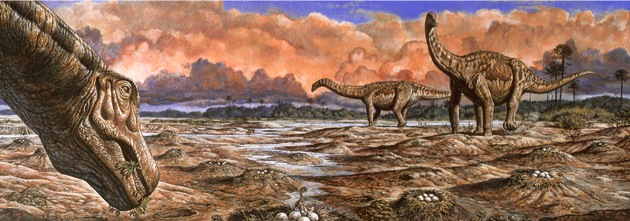Evolution & Phylogeny of Titanosauria

Chiappe, L. M., F. Jackson, R. A. Coria, and L. Dingus. 2005. Nesting titanosaurs from Auca Mahuevo and adjacent sites: understanding sauropod reproductive behavior and embryonic development; pp. 285-302 in K. A. Curry Rogers and J. A. Wilson (eds.) The Sauropods: Evolution and Paleobiology, University of California Press, Berkeley.
Jeff Wilson and Kristi Curry Rogers are co-PIs on an NSF-funded project that will investigate the phylogenetic relationships of the latest-surviving and perhaps most diverse sauropod lineage, Titanosauria. The pages on this site will be updated as the project progresses; eventually they will be a permanent archive of our study.
Titanosauria includes 40+ species that had a near-global distribution during the Late Cretaceous. Titanosaurs are also interesting because there are several gigantic and dwarf species that may imply differences in life history within the group. Titanosaurs are one of the few dinosaur groups that experienced a reduction in body size during their evolutionary history, which motivates us to investigate their life history. The footprint record suggests that titanosaurs adopted a novel ‘wide-gauge’ stance that may have allowed them to assume a tripodal stance more readily than other sauropods. New localities such as the Auca Mahuevo nesting site depicted above (e.g., Chiappe et al. 2005) are providing information about many aspects of titanosaur anatomy and paleobiology.
The aim of our study is to resolve the species-level relationships of Titanosauria. Character data for this analysis will include previously published characters, as well as novel characters gained from collections research and paleohistological data. The resultant phylogenetic hypothesis will allow us to investigate the paleobiological questions that motivate our study, such as the evolution of titanosaur body size, paleobiogeography, and locomotion.


